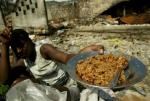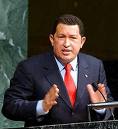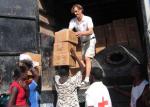Haiti Food Security Update (5/11/2008)
 Below is an update concerning food security in Haiti. First though, I read an interesting article in the Miami Herald about the critical role of coordination in Haiti relief efforts. In fact, it notes that an uncoordinated flow of aid can cause harm, particular in a setting like Haiti where food is plentiful on store shelves but most people can't afford it because of high unemployment and global price hikes. The best way to help Haiti right now is to contribute to both the organizations that can make a difference now and those that can help Haiti become self-reliant over the long-term.
Below is an update concerning food security in Haiti. First though, I read an interesting article in the Miami Herald about the critical role of coordination in Haiti relief efforts. In fact, it notes that an uncoordinated flow of aid can cause harm, particular in a setting like Haiti where food is plentiful on store shelves but most people can't afford it because of high unemployment and global price hikes. The best way to help Haiti right now is to contribute to both the organizations that can make a difference now and those that can help Haiti become self-reliant over the long-term.
 The Miami Herald article also noted that in order to improve coordination, about three dozen Miami-Dade County officials and activists have outlined a plan to address the crisis, from pressing for immigration reform for Haitians to debt relief from the Bush administration, to figuring out how best to feed people.
The Miami Herald article also noted that in order to improve coordination, about three dozen Miami-Dade County officials and activists have outlined a plan to address the crisis, from pressing for immigration reform for Haitians to debt relief from the Bush administration, to figuring out how best to feed people.
 The article also notes that the U.S. Southern Command in South Miami-Dade County is working to help the Pan American Development Foundation move 18, 40-foot containers of rice from the Midwest to Port-au-Prince. SouthCom is also helping an (unnamned) organization ship 500,000 high-nutrition meals to the Caribbean nation.
The article also notes that the U.S. Southern Command in South Miami-Dade County is working to help the Pan American Development Foundation move 18, 40-foot containers of rice from the Midwest to Port-au-Prince. SouthCom is also helping an (unnamned) organization ship 500,000 high-nutrition meals to the Caribbean nation.
 I should mention that negotiations continue over Ericq Piere, an international banker, and nominee for the Prime Minister of Haiti. According to Pierre - "The priorities in this country look very clear: We have to fight the high cost of living and try to create jobs. Jobs, jobs and jobs." Pierre went on to say that if he is confirmed, his government will pursue Preval's long-term goals of rebuilding agriculture, creating jobs, and overhauling the justice system and schools. I wish he would would have mentioned the importance of protecting the environment. Eight million Haitians can't all work in Port au Prince - the agricultural sector depends on reversing environmental degradation. Pierre supports the president's 275-page poverty reduction framework prepared with the World Bank and International Monetary Fund. I have not seen this document, please let us know if you have.
I should mention that negotiations continue over Ericq Piere, an international banker, and nominee for the Prime Minister of Haiti. According to Pierre - "The priorities in this country look very clear: We have to fight the high cost of living and try to create jobs. Jobs, jobs and jobs." Pierre went on to say that if he is confirmed, his government will pursue Preval's long-term goals of rebuilding agriculture, creating jobs, and overhauling the justice system and schools. I wish he would would have mentioned the importance of protecting the environment. Eight million Haitians can't all work in Port au Prince - the agricultural sector depends on reversing environmental degradation. Pierre supports the president's 275-page poverty reduction framework prepared with the World Bank and International Monetary Fund. I have not seen this document, please let us know if you have.
 The World Food Programme (WFP), the premiere food assistance organization, has received only 24% of the funds they need to ensure that the most vulnerable of the vulnerable can meet their basic food needs. Though his foundation Yele, Wyclef is teaming up with WFP to publicize their work.
The World Food Programme (WFP), the premiere food assistance organization, has received only 24% of the funds they need to ensure that the most vulnerable of the vulnerable can meet their basic food needs. Though his foundation Yele, Wyclef is teaming up with WFP to publicize their work.
 Hugo Chavez, the Venezuelan President, got involved as well. Chavez pledged to donate 15,000 metric tons of fertilizer, 50 tractors, 5000 tons of pesticide as well as other agricultural equipment and supplies. The value of the donations (if they materialize) could be as high as 15 million. Previous donations from Venezuela have on occasion been late, smaller than anticipated, or completely different than what had been pledged. We'll see how this turns out but agricultural inputs could be very useful if used correctly.
Hugo Chavez, the Venezuelan President, got involved as well. Chavez pledged to donate 15,000 metric tons of fertilizer, 50 tractors, 5000 tons of pesticide as well as other agricultural equipment and supplies. The value of the donations (if they materialize) could be as high as 15 million. Previous donations from Venezuela have on occasion been late, smaller than anticipated, or completely different than what had been pledged. We'll see how this turns out but agricultural inputs could be very useful if used correctly.
 Organizations on the ground emphasize the importance of monetary donations to buy food in Haiti, which helps stimulate the country's local economy. As a result of new customs procedures which were designed to encourage accountability (but at the expense of slowing the clearance process down), it would be difficult to get food out in a rapid manner. Cash assistance will do more than sending food. I hate to sound like a broken record, but we still get calls about food drives.
Organizations on the ground emphasize the importance of monetary donations to buy food in Haiti, which helps stimulate the country's local economy. As a result of new customs procedures which were designed to encourage accountability (but at the expense of slowing the clearance process down), it would be difficult to get food out in a rapid manner. Cash assistance will do more than sending food. I hate to sound like a broken record, but we still get calls about food drives.
 U.S. lawmakers unveiled a five-year global food aid plan last Thursday. The President had asked for flexibility to be able to provide cash instead of agricultural assistance. This would allow organizations to buy food locally, support economies, and better plan for emergencies. It takes time and money to get the food to where it has to go. The five year plan provides very limited flexibility - the message this sends is that the prosperity of U.S. farmers is much more important to Americans than that of hungry people living in food insecure environments. You can read more here.
U.S. lawmakers unveiled a five-year global food aid plan last Thursday. The President had asked for flexibility to be able to provide cash instead of agricultural assistance. This would allow organizations to buy food locally, support economies, and better plan for emergencies. It takes time and money to get the food to where it has to go. The five year plan provides very limited flexibility - the message this sends is that the prosperity of U.S. farmers is much more important to Americans than that of hungry people living in food insecure environments. You can read more here.
 HOPE II (Haitian Hemispheric Opportunity through Partnership Encouragement Act) was included in the farm bill thanks to the efforts of Democratic Reps. Charles Rangel of New York and Kendrick Meek of Miami. It expands duty-free access to the U.S. market for woven and knit clothing made in Haiti (using fabrics from countires outside the Western Hemisphere). One can't eat textiles and many of the companies that left during the last U.S. embargo probably will not come back. According to Jacqueline Charles and Pabo Bachelet, Haiti's textile industry has declined from more than 120,000 jobs at its height in the late 1980s to less than 17,000 before HOPE I was enacted in December 2006. Today there are about 22,000 jobs. To be fair though, even if it creates a handfull of jobs it will have been a step in the right direction.
HOPE II (Haitian Hemispheric Opportunity through Partnership Encouragement Act) was included in the farm bill thanks to the efforts of Democratic Reps. Charles Rangel of New York and Kendrick Meek of Miami. It expands duty-free access to the U.S. market for woven and knit clothing made in Haiti (using fabrics from countires outside the Western Hemisphere). One can't eat textiles and many of the companies that left during the last U.S. embargo probably will not come back. According to Jacqueline Charles and Pabo Bachelet, Haiti's textile industry has declined from more than 120,000 jobs at its height in the late 1980s to less than 17,000 before HOPE I was enacted in December 2006. Today there are about 22,000 jobs. To be fair though, even if it creates a handfull of jobs it will have been a step in the right direction.
As always, we'll keep you posted on new developments concerning food security in Haiti. Bryan The South Florida Sun-Sentinel ran an opinion piece urging increased action, stating it would be easier to help now than to respond to an emmigration crisis. For the most part, Haitians are staying put. The Brookings Institution, a respected think tank in Washington DC, ran a very good, accessible series on the global food crisis.
The South Florida Sun-Sentinel ran an opinion piece urging increased action, stating it would be easier to help now than to respond to an emmigration crisis. For the most part, Haitians are staying put. The Brookings Institution, a respected think tank in Washington DC, ran a very good, accessible series on the global food crisis.
Add new comment